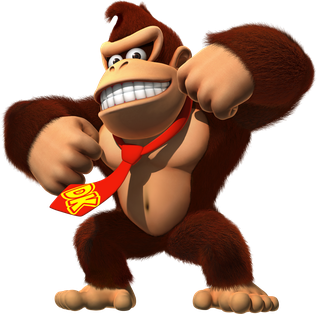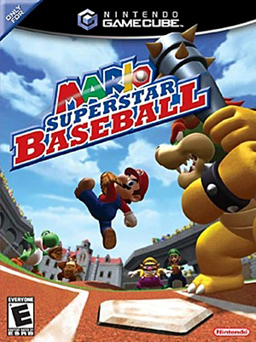
Donkey Kong, also shortened to DK, is a fictional gorilla-like character in the Donkey Kong and Mario video game series, created by Shigeru Miyamoto. The original Donkey Kong first appeared as the title character and antagonist of the eponymous 1981 game, a platformer by Nintendo, which would lead to the Donkey Kong series. The Donkey Kong Country series was launched in 1994 with a new Donkey Kong as the protagonist. This version of the character persists as the main one up to today. While the 1980s games' Donkey Kong and the modern Donkey Kong share the same name, the manual for Donkey Kong Country and subsequent games portray the former as Cranky Kong, the latter's grandfather, with the exception of Donkey Kong 64 and The Super Mario Bros. Movie, in which Cranky is depicted as his father, alternatively portraying the modern Donkey Kong as the original Donkey Kong from the arcade games. Donkey Kong is considered one of the most popular and iconic characters in video game history.

Donkey Kong Country is a 1994 platform game developed by Rare and published by Nintendo for the Super Nintendo Entertainment System (SNES). It is a reboot of Nintendo's Donkey Kong franchise and follows the gorilla Donkey Kong and his nephew Diddy Kong as they set out to recover their stolen banana hoard from the crocodile King K. Rool and his army, the Kremlings. The single-player traverses 40 side-scrolling levels as they jump between platforms and avoid obstacles. They collect items, ride minecarts and animals, defeat enemies and bosses, and find secret bonus stages. In multiplayer modes, two players work cooperatively or race each other.

Donkey Kong Country 2: Diddy's Kong Quest is a 1995 platform game developed by Rare and published by Nintendo for the Super Nintendo Entertainment System (SNES). It was released on 21 November 1995 in Japan, 4 December in North America, and 14 December in Europe. It is the second installment of the Donkey Kong Country series and the sequel to Donkey Kong Country (1994).

Donkey Kong Country 3: Dixie Kong's Double Trouble! is a 1996 platform game developed by Rare and published by Nintendo for the Super Nintendo Entertainment System (SNES). It was released in November 1996 in North America and Japan, and on 13 December in Europe and Australia. It is the third installment of the Donkey Kong Country series and serves as a direct sequel to Donkey Kong Country 2: Diddy's Kong Quest. It was also re-released for the Game Boy Advance (GBA) in 2005. The game was made available to download on the Wii's Virtual Console service in 2007, as well as for the Wii U's Virtual Console in 2014.

Donkey Kong Land is a 1995 platform game developed by Rare and published by Nintendo for the Game Boy. It condenses the side-scrolling gameplay of the Super Nintendo Entertainment System (SNES) game Donkey Kong Country (1994) for the handheld Game Boy with different level design and boss fights. The player controls the gorilla Donkey Kong and his nephew Diddy Kong as they defeat enemies and collect items across 30 levels to recover their stolen banana hoard from the crocodile King K. Rool.

Donkey Kong 64 is a 1999 platform game developed by Rare and published by Nintendo for the Nintendo 64. It is the only Donkey Kong game to feature 3D gameplay. As the gorilla Donkey Kong, the player explores themed levels to collect items and rescue his kidnapped family members from King K. Rool. The player completes minigames and puzzles as five playable Kong characters—each with their own special abilities—to receive bananas and other collectibles. In multiplayer modes, up to four players can compete in deathmatch and last man standing games.

Diddy Kong Racing is a 1997 racing video game developed and published by Rare for the Nintendo 64. The game is set on Timber's Island and revolves around Diddy Kong and his friends' attempt to defeat the intergalactic antagonist, a wizarding pig named Wizpig, through winning a series of races. The player can take control of any of the featured characters throughout the game. Diddy Kong Racing features five worlds with four racetracks each, and the ability to drive a car, hovercraft, or pilot an aeroplane. Timber Island is loosely based on the geographical landscapes of the United States.

Donkey Konga is a rhythm video game series for the GameCube starring Donkey Kong, developed by Namco and published by Nintendo. The series' games are played with a special controller called the DK Bongos that resemble two small bongo drums, but can optionally be played with the standard GameCube controllers.

Donkey Kong Jungle Beat is a 2004 platform and score-attack game developed and published by Nintendo for the GameCube. It follows the gorilla Donkey Kong as he sets out to defeat a series of evil kings to conquer the jungle. Jungle Beat is designed for use with the DK Bongos, a bongo drum-style GameCube controller created for the Donkey Konga (2003) rhythm game. The player controls Donkey Kong through various side-scrolling levels as he collects bananas, swings on vines, chains combos, rides animals, and defeats enemies and bosses.

Mario Superstar Baseball is a 2005 sports video game developed by Namco and published by Nintendo for the GameCube. The game was created in the vein of other Mario sports games such as Mario Golf: Toadstool Tour and Mario Power Tennis. A sequel, Mario Super Sluggers, was released for the Wii in 2008.

Donkey Kong Land 2 is a platform video game developed by Rare and published by Nintendo for the Game Boy. It is the sequel to the 1995 Game Boy game Donkey Kong Land and is part of the Donkey Kong video game series. It was released worldwide in Autumn 1996. It was enhanced for the Super Game Boy with different shades of color, as well as a 16-bit banana border on the edges of the television screen. Like the original Donkey Kong Land, it came packaged in a banana-yellow cartridge. The game was followed by Donkey Kong Land III, which was released in 1997.

Donkey Kong: Jungle Climber, also stylised as DK: Jungle Climber, is a puzzle-platform game developed by Paon and published by Nintendo for the Nintendo DS handheld video game console. It was released in Japan on August 9, 2007, and in western territories later that year. It was re-released for the Wii U's Virtual Console in Japan and North America in July 2015 and in Europe and Australia in August.

Donkey Kong Barrel Blast is a 2007 racing game for Nintendo's Wii video game console. The game was shown at the E3 convention in May 2006 for the GameCube under the title of DK: Bongo Blast, but this version was ultimately cancelled in favor of a Wii release. It was released for the Wii in Japan and the United States in 2007, and in PAL regions in 2008 with the title Donkey Kong Jet Race.
Donkey Kong is a video game series and media franchise created by the Japanese game designer Shigeru Miyamoto for Nintendo. The franchise follows the adventures of Donkey Kong, a large, powerful gorilla. Donkey Kong series include the original arcade game trilogy by Nintendo R&D1; the Donkey Kong Country series by Rare and Retro Studios; and the Mario vs. Donkey Kong series by Nintendo Software Technology. Various studios have developed spin-offs in other genres such as racing and rhythm. The franchise also incorporates animation, printed media, a theme park, and merchandise.

Mario Super Sluggers is a baseball adventure video game for the Wii developed by Namco Bandai Games and published by Nintendo. It is part of the Mario Sports series, and the sequel to Mario Superstar Baseball for the GameCube. Mario Super Sluggers was released in Japan on June 19, 2008 and in North America on August 25, 2008. It was not released in Europe and Australia.

Donkey Kong Country Returns is a 2010 platform game developed by Retro Studios and published by Nintendo for the Wii console. The game was released first in North America in November 2010, and in PAL regions and Japan the following month. The game's story focuses on an evil group of Tiki-like creatures known as the Tiki Tak Tribe that are unleashed on Donkey Kong Island and hypnotize the island's animals to stealing Donkey Kong and Diddy Kong's banana hoard, prompting the two to traverse the island to reclaim it.

Banjo-Pilot is a 2005 kart racing video game for the Game Boy Advance (GBA) and the fourth instalment in Rare's Banjo-Kazooie series. It plays similarly to the Mario Kart series by Nintendo: the player races one of nine playable characters around tracks, attacking other racers with bullets and collecting power-ups. The game features a number of single-player and multiplayer modes, such as time attack and item hunts. Unlike other kart racing games, characters control airplanes instead of go-karts.

Mini Mario & Friends: Amiibo Challenge is a 2016 puzzle-platform game developed and published by Nintendo for the Nintendo 3DS and Wii U. The seventh entry in the Mario vs. Donkey Kong series, the game was free to download on the Nintendo eShop, but requires Nintendo's Amiibo lineup in order to play. It was released in Japan in January 2016 and worldwide in April.

















